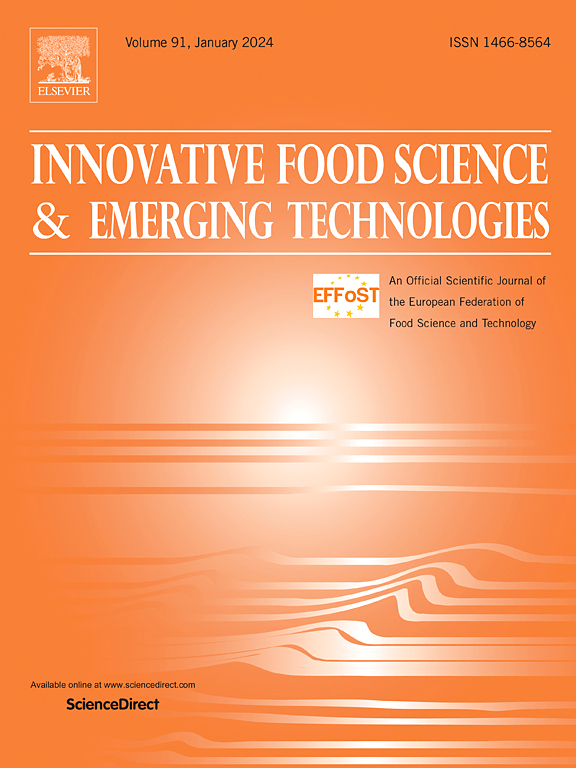Effect of high-pressure homogenization on soy hulls and okara with or without soy hulls: Characterization and functionalities
IF 6.3
1区 农林科学
Q1 FOOD SCIENCE & TECHNOLOGY
Innovative Food Science & Emerging Technologies
Pub Date : 2025-04-19
DOI:10.1016/j.ifset.2025.104028
引用次数: 0
Abstract
The production of soy milk and tofu may or may not involve a hulling step, generating two distinct by-products: okara from dehulled soybeans (okara㊀SH) and non-dehulled soybeans (okara㊉SH), which retain soy hulls (SH). The main objective of this study was to investigate the compositional and functional differences between these by-products and the effects of high-pressure homogenization (HPH) on their physicochemical, structural, and functional properties. Okara㊀SH, okara㊉SH, and SH were analyzed before and after HPH (1000 bar, 1 pass). Results showed that SH significantly impacted okara㊉SH composition, reducing protein content by 9 % (20.73 ± 0.02 %) while increasing cellulose by 46 % (15.44 ± 1.41 %) compared to okara㊀SH (22.61 ± 0.39 % protein, 9.88 ± 0.09 % cellulose). SH also influenced functional properties, lowering swelling capacity by 46 % (7.02 ± 0.69 to 3.80 ± 0.47 mL/g) and glucose adsorption capacity by 34 % (2.40 ± 0.18 to 1.58 ± 0.07 mmol/g) in okara㊉SH. HPH was beneficial for all samples; however, a positive effect of SH was observed for certain properties, such as oil-holding capacity (OHC). HPH significantly improved OHC, with increases of 467 % in SH (from 2.20 ± 0.02 g/g to 12.47 ± 0.68 g/g), 435 % in okara㊉SH (from 2.50 ± 0.05 g/g to 13.38 ± 0.51 g/g), and 425 % in okara㊀SH (from 2.78 ± 0.02 g/g to 14.60 ± 0.40 g/g). Moreover, water-holding capacity and solubility also improved post-HPH, suggesting enhanced application potential. Structural analysis confirmed HPH-induced modifications, including particle size reduction and matrix disintegration. These findings highlight HPH as a promising method for improving the functionality of soy by-products, particularly for food applications requiring enhanced water and oil retention properties.
高压均质化对带或不带大豆壳的大豆壳和大豆仁的影响:表征和功能
豆浆和豆腐的生产可能涉及也可能不涉及脱壳步骤,产生两种不同的副产品:脱壳大豆的okara (okara㊉SH)和保留大豆壳(SH)的非脱壳大豆(okara㊉SH)。本研究的主要目的是研究这些副产物的组成和功能差异,以及高压均质(HPH)对其物理化学、结构和功能特性的影响。Okara要在HPH (1000 bar, 1 pass)之前和之后分析Okara㊉SH和SH。结果显示,SH显著影响了okara㊉SH的组成,与okara要规范(22.61±0.39%蛋白质,9.88±0.09%纤维素)相比,蛋白质含量降低了9%(20.73±0.02%),而纤维素含量增加了46%(15.44±1.41%)。SH还影响了功能特性,降低了46%(7.02±0.69至3.80±0.47 mL/g)的溶胀能力和34%(2.40±0.18至1.58±0.07 mmol/g)的葡萄糖吸附能力㊉SH。HPH对所有样品均有益;然而,在某些特性方面,如持油能力(OHC),观察到SH的积极作用。HPH显着改善了OHC,其中SH增加了467%(从2.20±0.02 g/g到12.47±0.68 g/g), okara㊉SH增加了435%(从2.50±0.05 g/g到13.38±0.51 g/g), okara要活SH增加了425%(从2.78±0.02 g/g到14.60±0.40 g/g)。此外,hph后保水能力和溶解度也有所提高,表明应用潜力增强。结构分析证实了hph诱导的修饰,包括颗粒尺寸减小和基质崩解。这些发现强调HPH是一种很有前途的方法,可以改善大豆副产品的功能,特别是在需要增强水和油保留性能的食品应用中。
本文章由计算机程序翻译,如有差异,请以英文原文为准。
求助全文
约1分钟内获得全文
求助全文
来源期刊
CiteScore
12.00
自引率
6.10%
发文量
259
审稿时长
25 days
期刊介绍:
Innovative Food Science and Emerging Technologies (IFSET) aims to provide the highest quality original contributions and few, mainly upon invitation, reviews on and highly innovative developments in food science and emerging food process technologies. The significance of the results either for the science community or for industrial R&D groups must be specified. Papers submitted must be of highest scientific quality and only those advancing current scientific knowledge and understanding or with technical relevance will be considered.

 求助内容:
求助内容: 应助结果提醒方式:
应助结果提醒方式:


